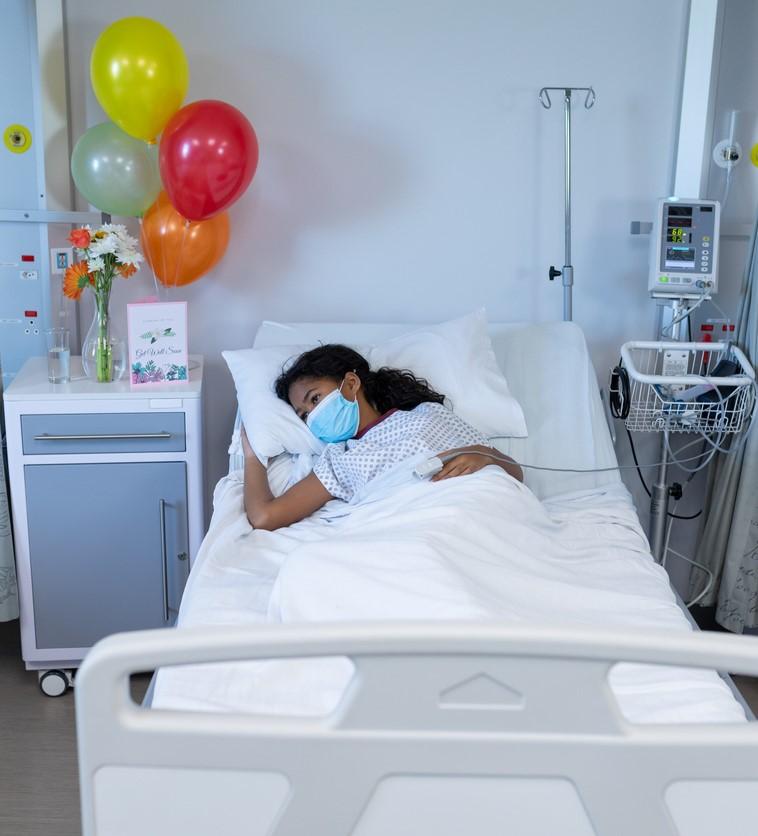Two studies today describe severe COVID-19 and the related multisystem inflammatory syndrome in children (MIS-C), the first detailing risk factors for pediatric intensive care unit (PICU) admission and death during hospitalization, and the second showing serious gastrointestinal (GI) symptoms.
Very low risk of death with MIS-C
UK researchers analyzed data on all hospitalizations of children 0 to 17 years in England from Feb 1, 2019, to Jan 31, 2021, related to COVID-19 and MIS-C in 2020 to 2021, nontraumatic causes in 2020 to 2021, and flu in 2019 to 2020. The findings were published in Nature Medicine.
Over the study period, which was before the harder-hitting Delta variant, 1,242,197 non-traumatic hospitalizations involved 892,906 children, 78% of them with only one admission. In 2020 and 2021, there were 470,606 hospitalizations, 6,338 of which were for COVID-19 in 5,830 children, 712 were for MIS-C in 690 children, and 463,556 were for other causes in 367,637 youth.
In contrast, in 2019 to 2020, there were 771,591 hospital admissions among 587,115 children, 6,968 were due to flu among 6,780 youth. Of the children admitted for MIS-C, 69.8% had no history of hospitalization, relative to 49.5% to 54.4% of children in other groups.
Of all COVID-19 patients, 4.1% were admitted to a PICU, compared with 43.8% of MIS-C patients, 1.1% of other pandemic year admissions, 0.9% of all admissions in 2019 to 2020, and 2.3% of flu admissions in that period.
Of the 6,338 COVID-19 hospitalizations, 259 led to PICU admission. Risk of PICU admission and death from COVID-19 or MIS-C was very low. Twenty-nine youth hospitalized with COVID-19 died within 28 days.
Of these deaths, eight were attributed to COVID-19. All had an underlying illness, and 7 of 8 had a life-limiting condition. Six MIS-C patients died by 28 days, of which no more than 4 were thought to be caused by the disease.
Risk factors for hospitalization, PICU stay
Hospitalizations for either COVID-19 or MIS-C were most common among boys, older children, those from disadvantaged neighborhoods, and Black, Asian, mixed-race, or other-race children. The chances of PICU admission were highest among children younger than 1 month, older children, girls with MIS-C, and Black patients with COVID-19 and MIS-C. The risk of PICU admission was lower in 15- to 17-year-olds than in 1- to 4-year-olds.
Odds of PICU admission for COVID-19 were higher among children with underlying medical conditions, especially those with multiple medical problems (53.9% had a comorbidity, 18.0% had a life-limiting comorbidity). Patterns of underlying diseases among MIS-C patients were different than those in other groups, with 68.3% having any comorbidity, of which 20.6% were life-limiting.
The increased likelihood of a PICU stay in COVID-19 patients was tied to certain underlying illnesses showing a comparable pattern in hospitalizations for other indications, which the authors said likely reflects background susceptibility.
"Although the pattern of risks was very similar, and absolute risks remained relatively small, increases in absolute risk of PICU admission were often higher for COVID-19 than for other cohorts, including influenza," they wrote. "This suggests that SARS-CoV-2 infection might magnify underlying risks faced by CYP [children] with chronic and life-threatening conditions."
Among MIS-C patients, 10.3% of hospitalizations were in infants, while over 85% were among those 1 to 14 years. Non-White youth made up 41.9% of COVID-19 admissions and 60.0% of PIMS-TS hospitalizations, higher than in other groups.
Understanding which children are at increased risk for COVID-19–related PICU admission and death will help guide healthcare providers, families, and policymakers in terms of strategies related to protective shielding and vaccination, they wrote.
"In marked contrast to adults, CYP were at very low risk of severe disease and death from COVID-19 or [MIS-C] during the first pandemic year," the authors concluded. "In the rare instances when CYP did require hospitalization, risk factors for severe disease were similar to those reported for adults."
1 in 10 may have severe GI problems
A multicenter study by Italian researchers on 685 pediatric COVID-19 patients found that 10% had severe GI involvement, which was linked to higher odds of hospitalization and ICU admission.
The study, published in JAMA Network Open, was conducted among inpatient and outpatient COVID-19 patients younger than 18 years diagnosed as having COVID-19 from Feb 25, 2020, to Jan 20, 2021. Median patient age was 7.3 years, 56.4% were boys, 91.7% had COVID-19, and 8.3% had MIS-C. Of all patients, 673 were White, 9 were Black, 2 were Hispanic, and 1 was Asian Indian.
Among all patients, 37.5% had GI symptoms (72.9% among the hospitalized), and 9.5% had severe GI involvement, including disseminated adenomesenteritis (inflammation of abdominal membranes; 39.6%), appendicitis (33.5%), abdominal fluid collection (21.3%), pancreatitis (6.9%), and intussusception (telescoping of the intestines) (4.6%).
Children with COVID-19 and GI signs and symptoms had higher odds of hospitalization (odds ratio [OR], 2.64) and ICU admission (OR, 3.90).
Among 65 children with severe GI conditions, (41.5%) underwent surgery. Severe GI problems were associated with age (OR for those 5 to 10 years, 8.33; OR for 10 and older), relative to preschool children. Similarly, severe GI manifestations were linked with abdominal pain (adjusted OR [aOR], 34.5), lymphopenia (aOR, 8.93), or MIS-C (aOR, 6.28). Diarrhea was tied to higher odds of adenomesenteritis (aOR, 3.13) and abdominal fluid collection (aOR, 3.22).
Of 192 COVID-19 patients, 74.7% had mild to moderate GI involvement, including diarrhea (55.71%), vomiting (30.2%), or abdominal pain (20.3%). Among the 57 children with a diagnosis of MIS-C, 77.2% had evidence of GI involvement. Twenty-four children were identified as having an intestinal pathogen such as rotavirus or Campylobacter species.
The authors noted that pediatric COVID-19 patients are more likely than adults to have GI symptoms, with about one quarter of kids with COVID-19 and nearly 90% of those with MIS-C developing diarrhea, nausea, vomiting, or abdominal pain. GI symptoms at COVID-19 onset has also been tied to higher odds of death in previous studies.
"Awareness about the factors associated with severe GI manifestations may help practitioners working either in emergency department or primary care settings to identify children with these diagnoses and manage children at risk for severe outcomes," the researchers concluded.
"A high grade of suspicion should be maintained in school-aged children and adolescents as well as all children presenting with abdominal pain, leukopenia, and elevated inflammatory markers or MIS-C who may require rapid abdominal imaging and surgical consultation."




















